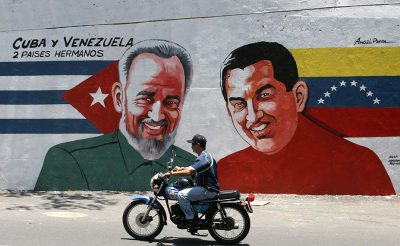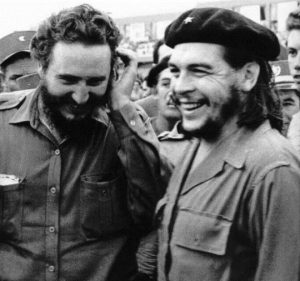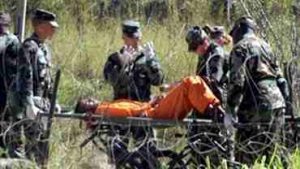The Cuban Revolution’s Survival in the Face of Six Decades of US Attacks

Examining the introduction of communism to Cuba over 60 years ago, and the revolution’s survival despite large-scale American attacks, one can conclude these occurrences would likely not have been possible without the involvement of Fidel Castro, the country’s former head of state. The Cuban revolutionary performed a central role in firstly overthrowing the US-backed dictator Fulgencio Batista in 1959 through guerrilla warfare, and he then held sway over Cuba for half a century, making him one of the world’s longest serving government leaders.
Castro was among the most influential men in living memory. The major figures in history, it can be noted, usually enjoy considerable popularity from the masses that they lead, assisting them greatly in their longevity. There are prominent examples of this over the past century alone: From Hindenburg and Hitler to Stalin, Churchill and De Gaulle, dictators or statesmen all of whom experienced significant support among their respective populations.
From 1959, until Castro’s death 57 years later, he enjoyed the backing of the majority of Cuba’s people. His popularity was highlighted early on by the Central Intelligence Agency (CIA) in a secret document since declassified, “he retains widespread support among the poorer classes”, in effect the Cuban population (1). This view is supported by a US National Security Council (NSC) Memorandum, which noted to its dismay how “Castro still has great support at the grass roots”. (2)
Nor was Castro’s popularity restricted to Cuba, as the CIA file even outlines. The longer his revolution survived the more he attained hero status with leftist circles across Latin America, and also in parts of Africa, following his direct intervention in that continent. An analysis of Castro’s career reveals that he produced two notable miracles: First, that he managed to evade over 630 illegal attempts on his life, a number of assassination plots on one person never compiled before or since, and yet – through extreme caution, cunning and some luck – he frustrated his enemies time and again.
The second miracle constitutes the fact that his revolution endured, despite concerted attempts to topple him by governments and special services of America, the world’s most powerful country. This latter miracle increases in scope when reflecting on the 1991 collapse of the USSR, Cuba’s major ally and largest trading partner by far. From the 1960s, it should be realised that Castro had little option but to place his country firmly in the Soviet camp, considering the rising antagonism and financial conundrums presented to Cuba by the White House. It was impossible to ignore too how Washington was ousting one government after another in Latin America and beyond, instituting dictatorships which resulted in widespread harm. (3)
As the Soviet Union was falling apart, Castro was by then aged in his mid-60s and in power for over 30 years. He was faced with what was his greatest challenge. The loss of Soviet support precipitated a level of devastation in Cuba, a small nation, that was worse than the turmoil inflicted by the Great Depression on North America and Europe. Moreover, Cuba remained under a punishing embargo enacted by Washington, which was tightened by the Clinton administration during March 1996 (4). In 1992 the CIA had estimated that Castro would survive for another two years, as recalled later by Wayne Smith, a former US diplomat.
On global issues, Castro was the first leader to address the climate change crisis. His warnings on this planetary threat were expressed as long as 28 years ago, at the June 1992 Earth Summit in Rio de Janeiro, Brazil – where 108 heads of state were present. Ian Angus, the experienced Canadian environmental activist, wrote of Castro’s stance on climate problems that he was the “one head of state who spoke out strongly in Rio and called for immediate emergency action”. Angus recounted that Castro “then returned home to support implementation of practical policies for sustainable, low emission development”. (5)
The World Wide Fund for Nature (WWF) subsequently reported that Cuba’s government implemented highly effective eco-friendly policies, achieving sustainable development (6). This strategy could have partly been out of necessity too, as the USSR’s demise demanded self-sufficiency and diversification of Cuba’s economy. The rest of the world, meanwhile, under the tightening grip of neoliberal globalisation, continued with corporate-engineered goals as carbon emissions reached record levels up to late 2019.
Castro was a vehement critic of neoliberalism, remarking on its lethal effects in speeches, broadcasts and trips abroad. Pertaining to other areas, the Cuban government wasted little time in enacting universal literacy programs in Cuba, while they also developed a remarkable healthcare system. From 1959 to 2005, the average life expectancy of Cuban citizens rose by 15 years, a greater increase by comparison to the US during the same time. This came in spite of an American blockade, which among other things deliberately targeted important medical equipment that Cuba could not obtain as a consequence.
The Canadian journalist and author, Keith Bolender, discerned that Cuban children are especially prone to the embargo’s brutal effects. Some youngsters have needlessly perished through being denied life-saving treatments for illnesses because of the US embargo. Bolender writes that one of the reasons for this strangulation “is to counteract the substantial amount of international political capital Cuba has achieved, with its involvement in sending doctors and staff around the world”. (7)
Havana’s focus on healthcare includes the pursuit of medical internationalism, mainly in the world’s poorer countries. During the coronavirus crisis, Cuba’s medical personnel have been at the frontline in some of the worst affected nations. Cuban doctors and nurses were, for example, flown to Spain and Italy to aid these reasonably wealthy states in their fight against Covid-19. The far-right government in Brazil, failing woefully to handle the virus, has in recent days been forced into a humbling U-turn by rehiring over 150 Cuban medical experts. (8)
Elsewhere, it can be noted that the Castro government played a decisive part in defeating rampant oppression and apartheid in southern Africa (9). From the 1970s, tens of thousands of Cuban troops were flown to the region, along with healthcare workers, teachers, technicians, etc.
While it is important to highlight the Cuban revolution’s commendable achievements, it may be necessary in covering some of its less palatable aspects. In July 2016 the acclaimed American author and activist Noam Chomsky, while at pains to mention the far more destructive US crimes, said “There have also been severe human rights violations” committed by Cuba’s authorities. (10)
This is primarily with regard to the shootings of Batista’s underlings. Many of these ex-Batista henchmen, previously bankrolled by Washington, had grisly records as murderers and torturers. Yet the execution of people, extrajudicially or not, can only be regarded as crimes which any human rights organisation will agree on. Instead of shooting Batista’s former loyalists, lengthy prison sentences should have been handed out which, not only more just and humane, would have acted as an equally firm deterrent.
Image on the right: Fidel Castro and Che Guevara
The executions were endorsed with rigour by Castro’s younger brother Raul, and likewise Ernesto “Che” Guevara, who sanctioned in writing some of them. Guevara wrote to a friend in early February 1959 that the shootings were “a necessity for the people of Cuba”. Richard Gott, the left-leaning English historian and Latin American specialist, outlined that “Guevara personally signed at least 50 death sentences, while Raul was alleged to have presided over the mass execution of 70 of Batista’s soldiers, shot down with machine guns in front of an open trench. Always known as a radical, with a toughness that bordered on brutality, Raul’s hawkish reputation was publicly confirmed by his elder brother”. (11)
Fidel commented that if he were killed, someone younger and more radical than himself would take over (Raul). As commander-in-chief, however, the older Castro was ultimately responsible for human rights abuses under his leadership. Gott, who travelled to Cuba on different occasions and had met Guevara, wrote that “Several hundred former Batista associates, policemen and torturers were shot by firing squad after perfunctory trials… the executions took the shine off the Revolution for many outsiders”. (12)
During the 1960s labour camps were erected in Cuba, where homosexuals and Jehovah’s Witnesses were sent in large numbers. Decades later Castro admitted these actions were a “great injustice”, and said that he had been distracted at the time with international emergencies like the Cuban Missile Crisis and repelling American hostility (13). Homosexuality in Cuba was decriminalised in 1979, 15 years before Germany.
In more recent times, complaints of human rights breaches against the Castro government, led by Human Rights Watch (HRW) and Amnesty International, have centred mostly on repression of civil liberties; rather than executions which had become increasingly rare. Due to the pressure on Cuba from the American colossus – which is growing again under president Donald Trump – one can at least understand the Cuban government for feeling paranoid, and in clamping down on protests. Extraordinary circumstances clearly exist in Cuba which should be taken into account, and placed into an historical context. Furthermore, HRW and Amnesty’s criticism of Cuba has been undermined by their somewhat dubious and ongoing support for opposition groups, such as the Ladies in White. WikiLeaks divulged evidence in 2011 that the Ladies in White have ties to American government branches, like the US Interests Section, and have received funding from them.
By far the worst human rights violations in Cuba this century, and perhaps in the entire Western hemisphere, have occurred along the country’s south-eastern corner – at the US-run Guantanamo Bay Naval Base – where a military prison was opened in January 2002 under president George W. Bush. Over elapsing years hundreds of prisoners taken from far flung places, many of them mere suspects, have been held at the Guantanamo prison camp without charge, and torture has been committed there on occasion (14). Other detainees have had no access to lawyers or family for extended periods.
The US assumed control of Guantanamo by force in 1903, and in recent decades Washington has refused Cuban requests that they relinquish it. Holding Guantanamo illegitimately has certain advantages for the US government; its occupation hampers Cuban development, as Guantanamo is the country’s biggest port and located in a strategically important area. It does not comprise part of US territory, allowing American authorities to act with impunity there, which they could not do were such a facility on the US mainland.
Focusing on Cuba’s government once more and specifically Castro, he professed himself to be “a Socialist, a Marxist and a Leninist” (15). Yet the latter figure, Lenin, from the beginning of his takeover of Russia had discarded many of the socialist ideals that his supporters had fought for. Chomsky said of Lenin and the Soviet Union,
“I would place the abandonment of socialism much earlier, under Lenin and Trotsky, at least if socialism is understood to mean at a minimum control by working people over production. The seeds of Stalinism were present in the early Bolshevik years, partly attributable to the exigencies of the civil war and foreign invasion, partly to Leninist ideology. Under Stalin it became a monstrosity”. (16)
Examining the system of governance in post-1959 Cuba, one can query whether socialism in reality exists there. Gott wrote that, “Castro allowed the Russians free rein in reorganising the Cuban economy, but in foreign affairs he ran the show himself” (17). From various literature available on Cuba, there is little evidence of public participation in production or economy, nor in decisions on foreign policy ventures, however heroic they were.
Nevertheless there are mitigating circumstances involved in Cuba’s case. This entails the huge blows unleashed on the country by successive US governments. The attacks, from terrorist campaigns and economic warfare to an invasion, rarely receive passing mention in the Western media, who limit their coverage to the apparently amusing assassination attempts on Castro. The US terrorism and other outrages perpetrated against Cuba are a serious matter indeed.
It began in the spring of 1959 with bombing and incendiary air raids, carried out by right-wing Cuban exiles operating freely from Miami, Florida. The aerial raids on Cuba increased in frequency during the winter of 1959-1960, causing some alarm on the island. It can be instructive to learn how the Castro government reacted.
Chomsky wrote that,
“We need not tarry on what the US or its clients would do under such circumstances. Cuba, however, did not respond with violent actions within the United States for revenge or deterrence. Rather, it followed the procedure required by international law. In July 1960, Cuba called on the UN for help, providing the Security Council with records of some twenty bombings, including names of pilots, plane registration numbers, unexploded bombs, and other specific details, alleging considerable damage and casualties and calling for resolution of the conflict through diplomatic channels”. (18)
Overwhelming evidence of attacks emanating from America was provided by Castro to the UN. America’s Ambassador to the UN, Henry Cabot Lodge Jr., assured that “the United States has no aggressive purpose against Cuba”, which was, to put it kindly, a falsehood. Four months before, in March 1960, the Eisenhower administration had made a formal decision in secret to overthrow Castro as soon as possible. Plans were formulating then for an invasion of Cuba which would take place the following year, in April 1961, at the Bay of Pigs under president John F. Kennedy. It failed dismally for the Americans but there were scores of dead on each side.
From November 1961 to January 1963, a 14 month period encompassing mostly the US terror plan Operation Mongoose, Castro estimated “there were a total of 5,780 terrorist actions against Cuba and, of those, 717 were serious attacks against our industrial facilities” (19). It may be impossible to corroborate these figures but the Italian-born historian, Piero Gleijeses, believes the declassified material available on Operation Mongoose alone is merely “the tip of the iceberg” and has been “heavily sanitised”.
The early terrorist attacks on Cuba – pursued mainly by the Kennedy administration – were a leading cause in the missile crisis occurring in October 1962, that almost resulted in nuclear war. The terrorism continued intermittently until the late 1990s, including also chemical and biological warfare. From a US government viewpoint, these efforts to destroy the Cuban revolution failed because they left virtually unharmed the political and military apparatus established by Castro and his advisers.
The US embargo has had the most devastating impacts overall. Even this cruel tactic did not succeed in attaining its principal goal because, once more, it is the Cuban people who have borne the brunt of suffering. Contrary to what was expected in Washington and Miami, the majority of Cubans were not going to stop supporting Castro just because they were being punished by their superpower neighbour.
*
Note to readers: please click the share buttons above or below. Forward this article to your email lists. Crosspost on your blog site, internet forums. etc.
Shane Quinn obtained an honors journalism degree. He is interested in writing primarily on foreign affairs, having been inspired by authors like Noam Chomsky. He is a frequent contributor to Global Research.
Notes
1 CIA Historical Review Program Release In Full 1997, “Prospects For The Castro Regime”, 8 December 1960
2 Office Of The Historian, “Foreign Relations Of The United States, 1958-1960, Cuba, Volume VI”, US National Security Council
3 J. Dana Stuster, “Mapped: The 7 Governments the U.S. Has Overthrown”, Foreign Policy, 20 August 2013
4 CNN, “Clinton signs bill aimed at Cuba”, 12 March 1996
5 Ian Angus, A Redder Shade of Green: Intersections of Science and Socialism (Monthly Review Press, 22 June 2017), p. 167
6 Telesur, “As World Burns, Cuba Number 1 For Sustainable Development: WWF”, 27 October 2016
7 Keith Bolender, Cuba Under Siege (Palgrave Macmillan; 2012 edition, 5 Dec. 2012), p. 86
8 Al Jazeera, “Brazil lets Cuban doctors resume work amid coronavirus struggle”, 19 May 2020
9 Sean Jacobs, “To so many Africans, Fidel Castro is a hero. Here’s why”, The Guardian, 30 November 2016
10 Noam Chomsky, Optimism over Despair (Penguin; 01 edition, 27 July 2017), p. 179
11 Richard Gott, Cuba: A new history (Yale University Press, 20 Aug. 2004), p. 168
12 Gott, Cuba: A new history, p. 168
13 The Globe And Mail, “Fidel Castro takes blame for 1960s gay persecution”, 31 August 2010
14 America Civil Liberties Union, “Guantanamo by the numbers”, May 2018
15 Fidel Castro, My Life: A Spoken Autobiography (Simon & Schuster Ome; Reprint edition, 9 June 2009), p. 157
16 Chomsky, Optimism over Despair, p. 177
17 Richard Gott, “Fidel remembered: a view of the Cuban revolution”, Magill, 29 February 2008
18 Noam Chomsky, Hegemony or Survival: America’s Quest for Global Dominance (Penguin, 1 January 2004), pp. 80-81
19 Castro, My life: A Spoken Autobiography, p. 252



